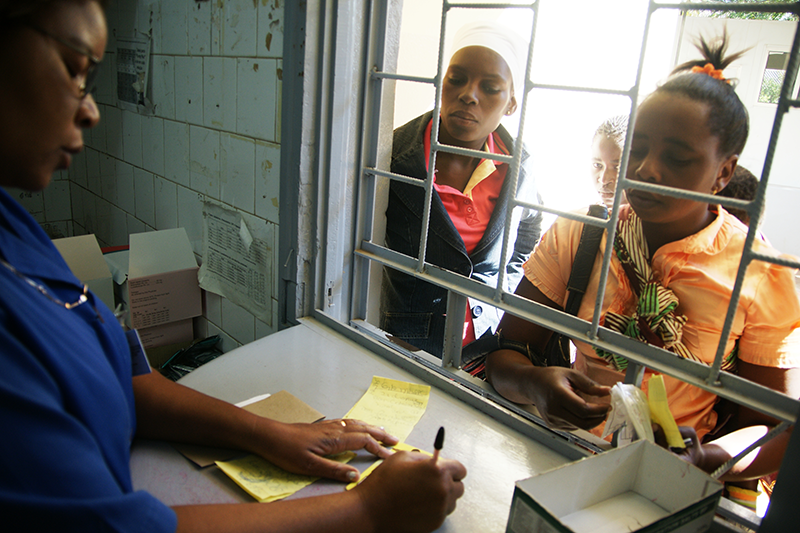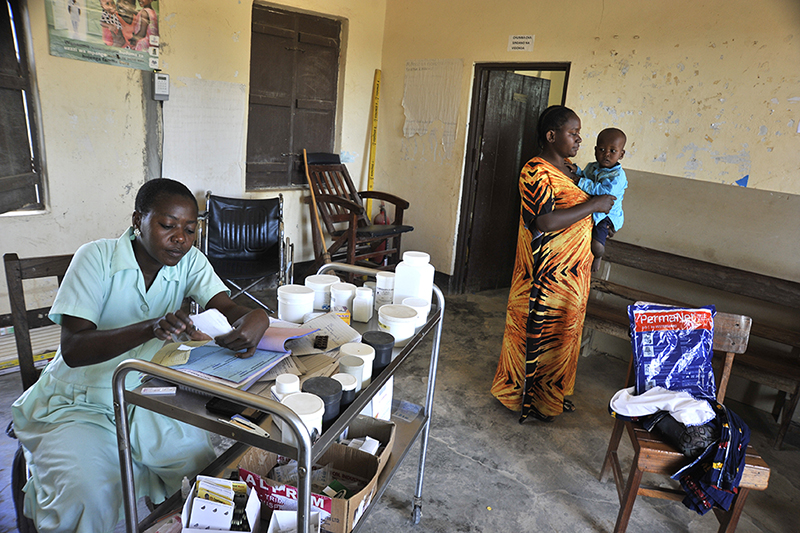All effective SBCC initiatives are based on context-specific strategies that are owned and implemented in partnership with health, media, private commercial companies, community organizations and politicians, among others. Both of these elements are essential: having a strategic plan and partnering with others. Here we will highlight some unique characteristics of designing SBCC programs and forming partnerships to address substandard and falsified ACTs and monotherapies.
A well-developed communication strategy is the foundation of a strong and effective campaign. It provides a “road map” for SBCC efforts, and ensures SBCC activities and outputs are coordinated and harmonized to achieve agreed-upon goals and objectives. It describes priority audiences, communication objectives, strategic approaches, positioning and messages.
For an in-depth orientation to designing communication strategies, log onto the self-paced SBCC online training Module 2: Focusing and Designing.
What Is the SSFFC Malaria Medicine Problem that the Communication Strategy Will Address?
Using the situation analysis from Step 1 will help identify the type of SSFFC malaria medicines problems going on in a country or community, the groups most affected by and affecting the problem, and the steps that various stakeholders are taking to reduce the availability and use of SSFFC malaria medicines.
The first step in strategy design is to write a clear statement of the problem it will address. Usually, this is done together with stakeholders, based on their common understanding of the problem.
Successful SBCC strategies focus on one specific issue that can be influenced through communication. Addressing too many issues or an issue that SBCC cannot change can be confusing.
To help focus the communication strategy, develop a focused problem statement, such as this one from Nigeria:
“An estimated 10 percent of malaria medicines available and being used [by malaria patients] to treat malaria in Nigeria are substandard or falsified.”
The problem statement names the health issue (malaria treatment) and indicates who is affected (malaria patients), where (nationally) and, if known, the extent of the problem (10 percent).
Who are the Audiences for this Communication Strategy?
 Next, define priority audiences for the communication strategy. Often called primary and influencing audiences, they are the people whose behavior must change in order to address the SSFFC malaria medicines problem. It is best to focus communication strategies on one or two priority audiences. This will allow program managers to concentrate resources and energy where they are most likely to have impact. Remember that each audience will need its own SBCC activities and materials, monitoring and evaluation systems.
Next, define priority audiences for the communication strategy. Often called primary and influencing audiences, they are the people whose behavior must change in order to address the SSFFC malaria medicines problem. It is best to focus communication strategies on one or two priority audiences. This will allow program managers to concentrate resources and energy where they are most likely to have impact. Remember that each audience will need its own SBCC activities and materials, monitoring and evaluation systems.
Usually, the audiences for a communication strategy are determined during a stakeholders meeting.
Primary Audience(s) are the group(s) of people programs want to directly influence with their messages. They are often the people who are directly affected by the problem or best able to address the problem. Strong primary audiences are groups who are:
- Directly affected by SSFFC antimalarials in the country or community
- Most at risk for SSFFC antimalarials in the country or community
- Make decisions or have influence on those affected
- Likely to make the biggest impact on the SSFFC malaria medicines problem
To not undermine confidence in malaria medicines, it is important to select primary audiences for whom there are realistic and doable actions.
Influencing Audiences (or Secondary Audiences) are the people who influence the primary audience, either directly or indirectly. Influencing audiences may include family members, service providers, medicine vendors or leaders who help shape social norms and treatment practices, influence policies or influence how people think about SSFFC antimalarials.
When considering audiences for SSFFC malaria medicines SBCC, use this tool below. Click on each audience and answer the questions.
Now that you have a list of possible primary audiences, determine a priority audience from these options by asking:
- What group is the most affected/at risk?
- What behavior would have the most impact on the SSFFC antimalarials problem in your country/community?
- What group is most crucial to addressing the problem? Is it necessary that you include this group as an audience?
- How likely will this group change within the timeframe of your SBCC program?
- Will focusing only on this group be enough to affect the problem? If not, what other groups should be involved?
- Does the SBCC program have the resources and reach to focus on this group? Consider engaging partners to reach groups that your organization may have trouble reaching.
Audience Analysis
Once you’ve determined your primary and influencing audiences, identify the socio-demographic, geographic, behavioral and psychographic characteristics of each priority and influencing audience. Define their communication preferences and other opportunities to reach them.
At this point, you might find that you do not have enough information about your priority audiences to conduct an analysis. If that is the case, you will want to conduct some quick formative research, such as focus group discussions or in-depth interviews with audience representatives.
Often audience analysis is done in small groups during a stakeholders meeting. Each small group is assigned an audience and given a worksheet with questions that guide their analyses.
When creating your audience profile, reflect on the following questions:
- What is the demographic profile of your audience?
- Age:
- Gender:
- Residence (urban/rural):
- Marital Status:
- Education level:
- Number of children:
- Socio-economic status:
- What is the desired behavior for this audience in regards to SSFFC malaria medicines? These should be specific behaviors that will address the problem statement.
- What does this audience currently do to address SSFFC malaria medicines?
- What are the main reasons why this audience is not adopting the desired behavior?
- What is the key constraint or the biggest constraint that prevents this audience from practicing the desired behavior? It should be a constraint that SBCC can affect in some way.
- Who or what influences their current practices regarding malaria medicines? What factors can influence the audience to adopt the desired practice?
- How does the audience get information? What are the most reliable sources of information to this audience?
Find further guidance on conducting an audience analysis here.
What are the Objectives of the Communication Strategy?
Your strategy should articulate a communication objective for each primary and influencing audience. Based on the audience analysis, the communication objective is a measurable statement that clearly and concisely states what the audience should know or think, what they should believe or feel and what they should do as a result of your communication. “SMART” communication objectives are Specific, Measurable, Attainable, Relevant and Time-bound. Monitoring and evaluating communication objectives helps to determine the extent to which your communication strategy succeeds.
Usually, the communication objective for each audience should deal with the key constraint to adoption of the desired behavior. For example, a primary audience for the Nigeria SSFFC malaria medicines campaign was consumers who buy anti-malaria medicines. Their biggest constraint to using good quality malaria medicines was their preference to self-diagnose and self-medicate, rather than visiting a health facility for diagnosis and treatment of malaria. The communication objective for this primary audience was:
"As a result of our SBCC campaign, malaria medicines consumers will know that self-medication exposes them to substandard and falsified malaria medicines that worsen the malaria problem, feel that money spent at the health facility is worthwhile since they are protected from SSFFC malaria medicines there, and go to the health facility if they experience malaria symptoms."
Some other examples of SMART communication objectives for SSFFC antimalarials include:
- Within four months, increase the proportion of people who can identify the manufacturer’s label, batch number and expiration date on a medicine packet from 20 percent to 50 percent.
- Within six months, increase from 10 percent to 30 percent the proportion of health providers in program sites who talk about quality medicines when providing positive malaria diagnoses to clients.
- Within one year, increase the number of national mobile verification service engagement by 25 percent.
For step-by-step guidance on developing communication objectives and templates to help with this element, refer to:
- Designing a Social and Behavior Change Communication Strategy
- How to Develop a Communication Strategy
What Strategic Approaches Should Be Employed?
Once you have determined your communication objectives, you will need to select strategic approaches to meet those objectives. Strategic approaches are the ways a SBCC intervention is packaged or framed into a single program, campaign or platform. Many campaigns and initiatives use multiple approaches to reach their audiences. There are many approaches and channels your program could use to promote change, including advocacy, community-based media, community mobilization, counseling, distance learning, information and communication technology (ICT), interpersonal communication (IPC)/peer communication, mass media, social mobilization and support media/mid-media.
The approaches that you choose will depend on the channels available and preferred by your audiences, as well as the behaviors that you are promoting. Some examples of strategic approaches for SSFFC antimalarials programs include:
- Advocacy among law enforcement agencies to tighten medicine regulation
- Community mobilization to raise awareness of SSFFC antimalarials and promote positive purchasing practices
- Counseling clients to verify the quality of their medicine when informing them about positive malaria test results
- Orientation of drug vendors to the dangers of SSFFC malaria medicines and how to recognize and report them
For step-by-step guidance on determining your communication approach, as well as detailed list of possible channels, refer to:
- Designing a Social and Behavior Change Communication Strategy
- How to Develop a Communication Strategy
- How to Develop a Channel Mix Plan
What Positioning Should Be Used?
Positioning is the heart of the SBCC strategy. It identifies the most compelling and unique benefit that the behavior offers the primary audience(s). Positioning is the emotional “hook” upon which the SBCC strategy hinges. It presents the desired behavior in a way that both persuades and appeals to the audience(s). Positioning ensures that messages have a consistent voice and that all planned activities reinforce each other for a cumulative effect.
Some examples of positioning statements for SSFFC malaria medicines are:
- Mothers who buy malaria medicines from only registered pharmacists are good mothers who care about their children’s health and well-being.
- Informal medicine vendors who buy medicines from quality, low-risk sources are protecting both the good reputation of their businesses and the communities they serve.
For step-by-step guidance on determining your communication approach, as well as a detailed list of the different possible channels, refer to:
- Designing a Social and Behavior Change Communication Strategy
- How to Develop a Communication Strategy
What Key Messages Should the Strategy Communicate?
 Key messages outline the core information to convey to audiences consistently and across all activities. Messages cut across all channels and must reinforce each other across these channels. Effectiveness increases when all SBCC approaches (e.g., community mobilization and mass media) communicate harmonized key messages expressed in different ways and build on each other. Well-designed messages are specific to the audience and clearly reflect both positioning and a specific element that drives or inhibits behavior (a behavioral driver). Key messages clearly describe the desired behavior, which must be an action the audience is able to do in order to be effective.
Key messages outline the core information to convey to audiences consistently and across all activities. Messages cut across all channels and must reinforce each other across these channels. Effectiveness increases when all SBCC approaches (e.g., community mobilization and mass media) communicate harmonized key messages expressed in different ways and build on each other. Well-designed messages are specific to the audience and clearly reflect both positioning and a specific element that drives or inhibits behavior (a behavioral driver). Key messages clearly describe the desired behavior, which must be an action the audience is able to do in order to be effective.
Some examples of key messages for SSFFC malaria medicines include:
- Confirm medicine quality by using scratchpad technology before buying malaria medicine
- Reduce the risk of buying poor quality medicine by purchasing from a regulated source
- Protect clients by telling them where to buy good quality malaria medicines during post-rapid diagnostic test counseling sessions
For step-by-step guidance on developing key messages, refer to:
- Designing a Social and Behavior Change Communication Strategy
- How to Develop a Communication Strategy
- How to Design SBCC Messages
How To Build Stakeholder Ownership and Participation in the Strategy
Many actors are involved in efforts to protect malaria patients from poor quality ACTs and monotherapies. Each group has their own perspectives, roles and resources. In conducting your situational analysis, you may have reached out to members of a number of roles and perspectives, including those from medicine regulatory and professional associations, pharmaceutical manufacturers and distributors, government malaria control programs, civil society groups, criminal investigation and law enforcement agencies, and media and communication specialists. Involving as many of these partners as possible will strengthen your communication strategy, and expand its reach. When partners sit together to design communication plans and messages, they are more likely to own them and use them. This reduces duplication of efforts and promotes sharing of resources.
One way to engage partners from the beginning is to invite their participation in a strategy design workshop. During this workshop, invite key representatives from each of the five groups consulted during the situation analysis to present their experiences, research and programs. Share your situation analysis for their validation and to frame decisions concerning audiences and communication objectives.
Structure the workshop to invite stakeholder participation in making key strategic decisions (e.g., audience identification and analysis, identify gaps and appropriate calls to action, communication objectives and essential message content, etc.). Invite their participation on a SSFFC malaria medicines communication advisory group to provide input on the final communication strategy and the design of communication materials and activities. Request they implement SSFFC malaria medicines activities and use the communication materials alongside their usual work, and ask them to participate in monitoring and evaluation activities.
![]() See an example strategy design workshop agenda and report from Nigeria. To learn more about conducting an SBCC communication strategy design workshops, see How to Conduct a Stakeholder Workshop.
See an example strategy design workshop agenda and report from Nigeria. To learn more about conducting an SBCC communication strategy design workshops, see How to Conduct a Stakeholder Workshop.
What Does an SSFFC Malaria Medicines SBCC Strategy Look Like?
Communication strategies will vary from country-to-country, depending on the type of problem, audience and local solutions available.
![]() See an example of Nigeria’s Communication Strategy to Address SSFFC Malaria Medicines. Please share your SSFFC malaria medicines communication strategies via this form.
See an example of Nigeria’s Communication Strategy to Address SSFFC Malaria Medicines. Please share your SSFFC malaria medicines communication strategies via this form.
For an in-depth orientation to designing communication strategies, you can also log onto the self-paced SBCC online training Module 2: Focusing and Designing. Also, if your strategy revolves around developing a quality-assured brand, see HC3’s series on How to Create a Brand Strategy Part 1, Part 2 and Part 3.





No Comments